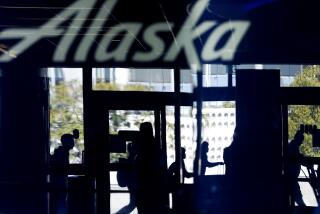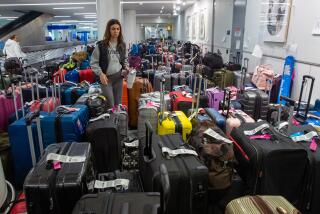Outsourcing cuts carriers’ costs, but at what cost to fliers?
- Share via
THAT plane you’re flying on may have been assembled in America, but where was it last serviced? Increasingly, the answer is this: not in the airline’s hangars and maybe not even in this country.
Outsourcing of repairs and maintenance is spreading through the cash-strapped airline industry. Carriers that outsource say they save money, achieve quicker turnarounds and get higher-quality work by hiring contractors who specialize in servicing jets.
U.S. carriers contract out 53% of their aircraft maintenance expense, the U.S. Department of Transportation said in July, an increase of 6% from 2003.
Most repair stations that are operated by U.S. airlines or stations that work on U.S. planes are in this country. But more than 13% are abroad, in places such as Singapore, Hong Kong, El Salvador, China and South Korea, according to the Federal Aviation Administration.
Experts I spoke with didn’t point to any data that suggest jet maintenance done by outside contractors here or abroad is less sound than work the airlines do in-house.
But opinions on outsourcing abound. And there may be reasons for concern.
Some aircraft inspectors and industry analysts say they worry that repair stations aren’t adequately monitored. Airlines and the FAA, which regularly checks maintenance facilities used by U.S. carriers, say they are.
In a report in June, the DOT’s Office of Inspector General said FAA inspections had not kept pace with the growth in repair stations. The FAA “needs to place more emphasis on oversight of outsourced maintenance,” the DOT concluded.
The department also expressed concern about FAA staffing. It said the agency was expected to lose about 300 aviation-safety inspectors this year and had requested only 97 replacements for next year.
The Professional Airways Systems Specialists, a union representing FAA inspectors, said the DOT report pointed to major deficiencies.
Linda Goodrich, the union’s national vice president for flight standards, said outsourcing, combined with a shortage of FAA inspectors, represented a “serious threat to aviation safety.”
Monitoring foreign repair stations is especially difficult, she said, because “there’s this huge language and communication barrier.” Inspectors often have to work through translators, she said, and they may not be familiar with training facilities, for instance, in a foreign country.
The criticism by Goodrich and the DOT echoed that leveled against the FAA nearly a decade ago after a ValuJet Airlines plane caught fire and crashed in Florida, killing 110 people.
The National Transportation Safety Board attributed the 1996 accident to improper loading of oxygen tanks by an outside contractor. It faulted ValuJet and the FAA for inadequately monitoring the maintenance station.
Likewise, the NTSB criticized the FAA in the 2003 crash of a US Airways Express/Air Midwest turboprop in Charlotte, N.C., that killed 21 people.
Although the plane was overweight, investigators found that incorrect rigging of the elevator system by a contractor also contributed to the accident. They cited “lack of oversight” of the maintenance facility by Air Midwest and the FAA.
But such accidents are rare. Only about 1 in 16 million flights by U.S. carriers results in fatalities, the FAA says. In fact, the last three years have been the safest in history for America’s commercial aviation, even as outsourcing of repairs and maintenance has grown.
Laura Brown, an FAA spokeswoman, attributed that record to “a lot of hard work by the aviation industry” to forestall problems.
Along with the airlines, 1,785 FAA inspectors monitor more than 5,000 repair stations used or owned by U.S. carriers worldwide. Rejecting criticism by the employees union, Brown said: “We believe we have adequate staffing.”
FAA inspectors regularly do safety audits of repair stations, she said, checking work procedures, certification of employees and other processes. In some cases, a foreign government’s civil aviation authority may perform the inspections on behalf of the FAA.
“We can’t be out there kicking every tire and watching every wrench being turned,” Brown said. “[But] we still do kick a few tires.”
Airlines also say they closely monitor repair stations.
Jim Sokol, vice president of maintenance and engineering for Southwest Airlines, which contracts out three-fourths of its jet maintenance to U.S. companies, said Southwest conducts safety audits at least twice a year and sometimes monthly at each of its contractors.
Jeff Green, spokesman for United Airlines, which next month is to begin sending its 52-plane fleet of 777s to China for service, said United maintained staff on site at all its U.S. and foreign repair stations.
“Safety is our No. 1 priority,” he said. “It’s something we would never compromise.”
Industry experts say airlines are motivated to be careful. They can be held legally responsible for maintenance mistakes, outsourced or not, that contribute to accidents.
“My gut reaction,” said Ron Kuhlmann, vice president of Unisys R2A, transportation consultants near San Francisco, “is no one is willingly or knowingly going to accept inferior maintenance because the consequences are just too dreadful.”
A study by Kuhlmann’s company in July found that extensive outsourcing is not a universal practice. But most carriers at least contract out engine maintenance, typically to the manufacturer.
“Most of our work is done with companies that actually designed the equipment,” said Southwest spokeswoman Brandy King. “So we feel they know it better than anyone.”
Another service that airlines commonly outsource is so-called heavy maintenance: tip-to-tail jet overhauls, performed every few years, that may take two weeks or more.
But Kuhlmann also found another trend: Many U.S. carriers service planes and parts for third parties such as the U.S. military and foreign airlines. The idea is to make money and keep repair stations busy during slow times.
American, which does most of its own maintenance, is courting such business.
Carmine Romano, American’s vice president of Tulsa, Okla.-based maintenance, said that in the last five years, his station had cut its turnaround time for engine overhauls by half or more to compete for contracts.
It recently won a bid to maintain 29 aircraft for a Brazilian start-up airline.
You might call this in-sourcing -- one of many experiments by a troubled industry trying to cut costs and improve efficiency.
Jane Engle welcomes comments but can’t respond individually to letters and calls. Write to Travel Insider, L.A. Times, 202 W. 1st St., L.A., CA 90012, or e-mail jane.engle@latimes.com.
More to Read
Inside the business of entertainment
The Wide Shot brings you news, analysis and insights on everything from streaming wars to production — and what it all means for the future.
You may occasionally receive promotional content from the Los Angeles Times.










